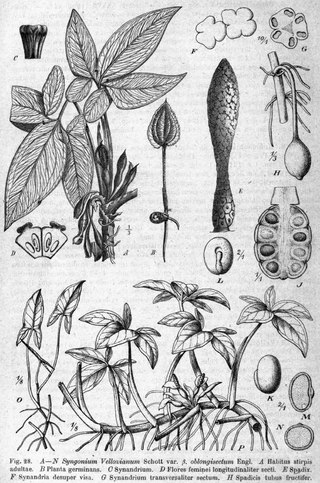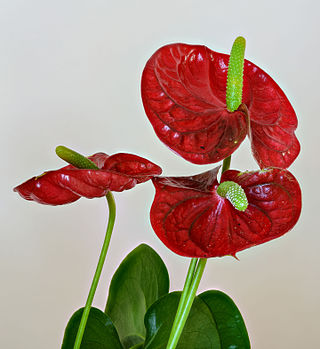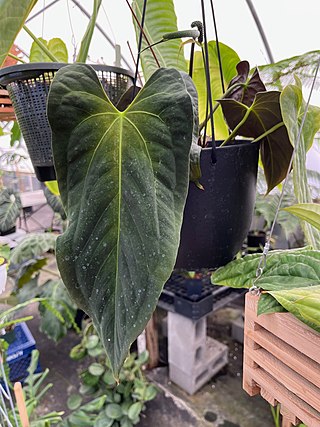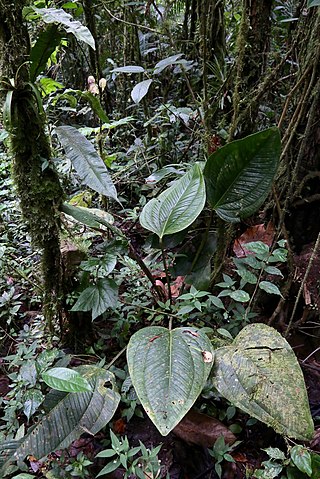
Syngonium is a genus of flowering plants in the family Araceae, native to tropical rainforests in southern Mexico, the West Indies, Central and South America. They are woody vines growing to heights of 10–20 m or more in trees. They have leaves that change shape according to the plant's stage of growth, and adult leaf forms are often much more lobed than the juvenile forms usually seen on small house plants. The scientific name of the genus comes from the Greek words σύν and γονή and refers to the fused ovaries of female flowers.

Anthurium is a genus of about 1,000 species of flowering plants, the largest genus of the arum family, Araceae. General common names include anthurium, tailflower, flamingo flower, and laceleaf.

The Berberidaceae are a family of 18 genera of flowering plants commonly called the barberry family. This family is in the order Ranunculales. The family contains about 700 known species, of which the majority are in Berberis. The species include trees, shrubs and perennial herbaceous plants.

Podophyllum peltatum is an herbaceous perennial plant in the family Berberidaceae. Its common names are mayapple, American mandrake, wild mandrake, and ground lemon. It is widespread across most of the eastern United States and southeastern Canada.

Guihaia is a genus of three species of dioecious palms found in China and Vietnam. Perhaps its most distinctive characteristic is that it is the only palm with palmate leaves that has reduplicate (A-shaped) leaf folds. All other palmate leaves have induplicate (V-shaped) leaf folds. Guihaia lancifolia has undivided leaves.

Pachyneurium is a section within the genus Anthurium. It is the largest section, containing the "birdsnest" Anthuriums. Plants of the section are terrestrial, with a rosette growth habit of dense, deeply rooted stems, and long lanceolate to oblanceolate leaves. Leaves are borne on short petioles and often have waved margins. The most notable characteristic is in the rolling of new leaves. Anthurium of all other sections are rolled in a simple spiral, resembling a conch shell; those of Pachyneurium are rolled in two opposite spirals towards the central rib of the leaf.

Anthurium pedatoradiatum or Anthurium Fingers is a species of plant in the genus Anthurium native to southern Mexico. A. pedatoradiatum has leaves with deep finger-like sections, and is terrestrial. Its natural habitat is from sea level up to 1,000 meters (3,300 ft) in the Mexican states of Veracruz, Tabasco, and Chiapas. It is related to other Anthurium in the section Schizoplacium such as Anthurium podophyllum, and its species name in Latin refers to the radiating growth of its palm-like leaves.

Anthurium oxycarpum is a species of flowering plant in the genus Anthurium. It can be found in Central and South America from southeast Colombia to Bolivia and northern Brazil. One of the "birds nest" Anthurium species, it grows terrestrially. In its native land, the dried leaves–which smell fragrantly like vanilla and musk when dried–are sometimes smoked or used as snuff.

Anthurium magnificum is a plant in the genus Anthurium native to Colombia. Closely resembling other Anthurium species like Anthurium crystallinum, it has large, cordate leaves with prominent veining and is primarily terrestrial. Plants of the true species can be distinguished primarily by their quadrangular petioles.

Anthurium coriaceum is a species of plant in the genus Anthurium native to southeast Brazil. A "bird's nest" type of Anthurium of the section Pachyneurium, it grows either terrestrially or epilithically in areas of seasonal dryness. It has erect leaves that feel like leather, which is where its scientific name derives from.

Anthurium papillilaminum is a species of plant in the genus Anthurium native to Panama. A. papillilaminum grows terrestrially and has very dark green cordate leaves on short stems. Its native range is very limited, with the species endemic to only the coasts of Colón Province and Darién Province up to 100 meters (330 ft) above sea level. A member of the section Cardiolonchium, it is closely related to other velvet-leaved Anthuriums, though it does not have silver veins on the leaves like Anthurium crystallinum.

Anthurium corrugatum is a species of plant in the genus Anthurium native to Central and South America from Panama to Ecuador. This species is noted for its cordate leaves with a network of fine veins that gives it a bullate appearance. A terrestrial grower, it is adapted to cool, humid climates. It is a member of the section Polyneurium along with Anthurium argyrostachyum and others.

Anthurium clavigerum is a species of plant in the genus Anthurium. Native to Central and South America, it ranges from Honduras to central and western Brazil. This epiphyte has distinctive leaves that are deeply lobed and sometimes sinuous edges. The main stem can be several meters long and the palmate leaves can be 2 meters across, giving it the largest foliage of any Anthurium in Central America.

Anthurium microspadix is a species of plant in the genus Anthurium. Growing as an epiphyte or a terrestrial shrub, it is native from the southern Mexican states of Oaxaca and Chiapas to Bolivia from 800–2,300 metres (2,600–7,500 ft) in elevation. One of the more widely distributed and variable species in its genus, it is easily confused with species such as Anthurium pallens and others.

Anthurium formosum is a species of plant in the genus Anthurium native to Central and South America. Epiphytic or terrestrial, it is found from Nicaragua to Colombia and northwest Venezuela.

Anthurium bonplandii is a species of plant in the genus Anthurium native to South America. A member of the Anthurium sect. Pachyneurium, it grows terrestrially or occasionally epiphytic or epilithic. It is often confused with Anthurium jenmanii when young and Anthurium atropurpureum.

Anthurium dwyeri is a species of plant in the genus Anthurium native from Costa Rica to the Chocó Department of Colombia. Named in honor of the botanist Dr John D. Dwyer, it has no known close relatives but is a member of the section Porphyrochitonium. An epiphyte, it is most easily recognizable by its leathery, oblong to elliptical leaves that are 24–40 centimetres (9.4–15.7 in) long and grow on triangular stems.

Anthurium coloradense is a species of plant in the genus Anthurium native to Panama. A member of the section Polyneurium, this terrestrial shrub is most recognizable by its thin, veined leaves and its yellow-green spadix. Its foliage is very similar to other Panamanian species such as Anthurium caperatum, Anthurium santamariae and Anthurium cerrosantiagoense but may be distinguished by details such as the grooves in its stems and the pattern of veining, with the collective vein growing from the third vein in a leaf.

Anthurium wendlingeri is a species of plant in the genus Anthurium found in Central and South America, from southeast Nicaragua to northwest Colombia. It grows in wet tropical habitats as an epiphytic shrub with long, pendant leaves up to 7 feet (2.1 m) long that can have a slightly velvety appearance.

Anthurium ovatifolium is a species of plant in the genus Anthurium native to Colombia, Ecuador, and Peru. It grows in wet tropical habitats, and is a member of the section Digitinervium. Its species name refers to the oval shape of its leaves, and it can be distinguished from similar species like Anthurium lentii by its red berries.




















